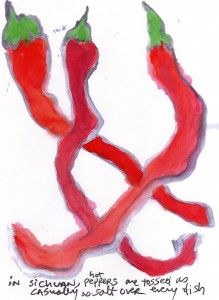At the Toronto Hakka Conference I was asked to give a presentation on Modern Hakka Cuisine. I’ve collected many photos from my travels and decided to show what I saw and tasted around the world. Everywhere I traveled, I asked people what is Hakka food. I received answers such as honest, earthy comfort food of the working man. Other descriptions included strong robust flavors, fatty, salty, lots of pork and soy sauce, preserved vegetables, cured meats, rice wine and its residue. Food is hearty, direct, and satisfying.
As I traveled, I realized that the Hakka cuisine was far more diverse than its common perception. True, many of the descriptions applied to the roots of this cuisine, but through migration, creative chefs, changing life styles, and regional influences, the definition of the cuisine had greatly expanded. Hakka food had dark soulful dishes such as kiu ngiuk moi choi (pork belly steamed with preserved mustard greens) but it also had dishes that emphasized the natural essence of the ingredients with uncomplicated fresh presentations. The cuisine is much like its people. It has traveled the world and adapted to new environments, local ingredients, and prevailing tastes to become a varied cuisine. Yet it still maintains its roots.
In the area around Meizhou, the Hakka heartland, the food was the most traditional with many classics such as salt-baked chicken, stuffed tofu, fried eggs with preserved vegetables. As it left its mountainous homeland, the cuisine seemed to blossom with new ingredients, more seafood, fresher options.
In some regions such as in Sichuan province, chiles made a bold statement. Inventive chefs created new specialties and adapted to local ingredients. Others lightened dishes to appeal to a changing lifestyle and the younger generation. Back home, the food seemed to take on a California freshness.
Yet I’m surprised even in its migration, the heart of Hakka food still retains its soulful roots and many traditional dishes tastes remain relatively unchanged. This traveling kitchen is a work in progress, growing as it travels.


